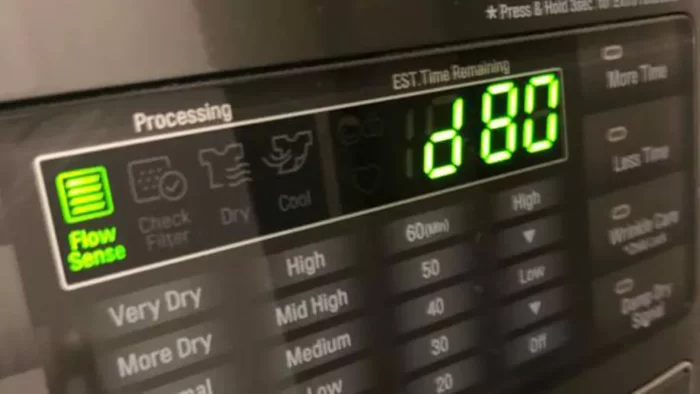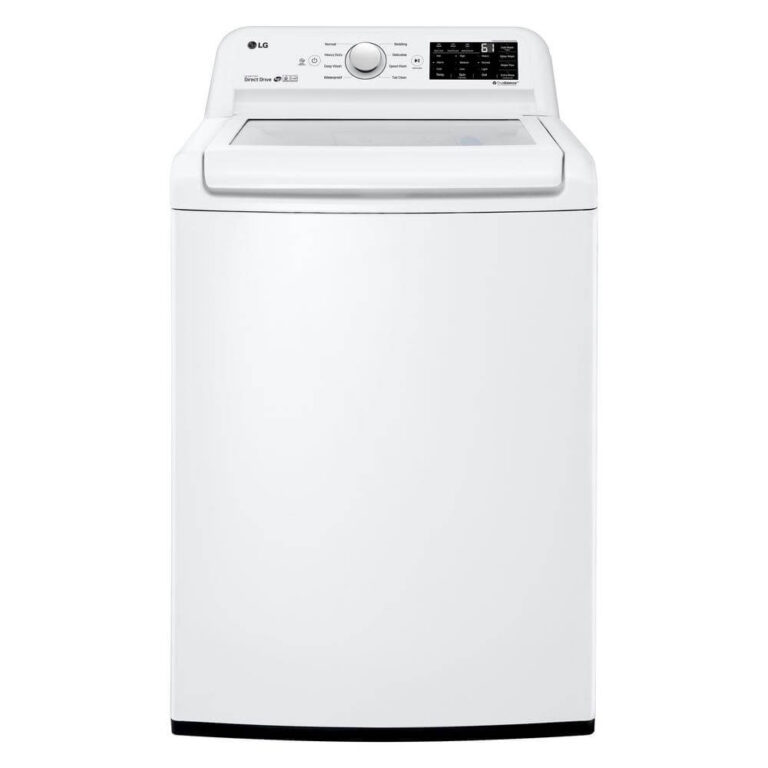LG Dryer D80 No Blockage: Troubleshooting the Mystery
Introduction
The Dreaded LG Dryer D80 Error Code
If you’re the lucky owner of an LG dryer, you may have encountered the infamous D80 error code at some point during your laundry endeavors. This error code is typically displayed when the dryer detects that there is a blockage in the exhaust vent, preventing proper airflow and causing your clothes to take longer to dry. While it may seem like a minor inconvenience, ignoring this issue can lead to more serious problems down the line.
Why Addressing the Issue is Important
First and foremost, an obstructed exhaust vent can be a fire hazard. In fact, according to the National Fire Protection Association, dryers are responsible for nearly 15,000 house fires each year in the United States alone.
Additionally, a blocked vent can cause your dryer to work less efficiently, resulting in longer drying times and higher energy bills. And let’s not forget about the frustration of having to run multiple cycles just to get your clothes fully dry.
In short, addressing this issue as soon as it arises not only improves the safety of your home but also saves you time and money in the long run. Fortunately, there are several troubleshooting steps you can take to remedy this problem and prevent it from happening again in the future.
Understanding the D80 Error Code
What the Error Code Means
If you own an LG dryer, you may encounter the dreaded D80 error code. This code appears on the display panel when the dryer exhaust system is experiencing restricted airflow. Essentially, your dryer thinks there is a blockage somewhere in its system preventing proper ventilation and airflow.
This can cause a number of issues such as poor drying results, longer drying times, and even damage to your clothes. Understanding what the D80 error code means is crucial in addressing the issue and getting your dryer back to its optimal performance.
Possible Causes of the Error Code
There are several reasons why your LG dryer may be displaying the D80 error code. One of the most common causes is a clogged lint filter or exhaust vent. When lint and other debris accumulate in these areas, it restricts airflow and triggers this error code.
Another possible cause could be damaged ductwork or improperly installed venting. If there are kinks or obstructions in your dryer’s ductwork, it can cause restricted airflow leading to this error code.
Faulty sensors and thermostats could also be causing this issue. These components are responsible for monitoring temperature levels within your dryer’s system.
If they malfunction or fail altogether, it can trigger the D80 error code as well. Understanding these possible causes can help you determine where to begin troubleshooting and resolving this issue with your LG dryer’s performance.
Troubleshooting Steps for No Blockage Issue
Checking Lint Filter and Exhaust Vent for Blockages
One of the first steps to take when dealing with an LG dryer D80 no blockage issue is to check the lint filter and exhaust vent for blockages. This is because a clogged lint filter or exhaust vent can cause the dryer to overheat, which can trigger the D80 error code.
To do this, simply remove the lint filter and clean it thoroughly. Then, check the exhaust vent outside your home and make sure there are no obstructions.
If you find that either the lint filter or exhaust vent is blocked, clear it out immediately. You’ll likely notice a significant improvement in your dryer’s performance once these blockages have been removed.
Inspecting and Cleaning Ductwork
If you’ve ruled out a clogged lint filter or exhaust vent as the cause of your LG dryer’s D80 error code, then it’s time to inspect and clean your ductwork. The ductwork is responsible for carrying hot air out of your dryer and away from your home. Over time, ductwork can become clogged with dust, debris, and other particles.
When this happens, airflow through the ducts becomes restricted, leading to overheating issues in your dryer. To inspect your ductwork, simply disconnect it from both sides (the back of the dryer and where it exits your house) and use a flashlight to look inside.
If you notice any blockages or buildup in your ducts, clear them out with a vacuum cleaner or long-handled brush. You should also consider hiring a professional to clean out your ducts if they haven’t been cleaned in several years.
Testing Sensors and Thermostats
If neither of these troubleshooting steps has resolved your LG dryer’s D80 no blockage issue, then it’s time to move on to testing the sensors and thermostats. These are important components of your dryer’s heating system, and if they’re not functioning properly, you’ll likely experience overheating and other related issues. To test these components, you’ll need to consult your dryer’s manual or hire a professional for assistance.
In general, however, you can use a multimeter to test for continuity in the various sensors and thermostats in your LG dryer. If any of these components are found to be faulty, they will need to be replaced before your dryer will function properly again.
By taking these troubleshooting steps, you should be able to identify and resolve any no blockage issues with your LG dryer that are triggering the D80 error code. Remember to always follow proper safety procedures when working with electrical appliances, and don’t hesitate to call in a professional if necessary.
Tips for Preventing Future Issues
Regular Maintenance Practices to Keep Dryer Running Smoothly
Taking care of your LG dryer is important in preventing future issues and ensuring it runs smoothly. A simple maintenance practice that you can perform is cleaning the lint filter after every use. This will prevent a buildup of lint, which can cause blockages and increase the risk of fires.
Additionally, cleaning out the exhaust vent regularly helps to maintain proper airflow and reduces the risk of overheating. Another way to keep your dryer running efficiently is by inspecting and cleaning ductwork periodically.
Over time, ductwork may accumulate debris, such as lint or dust, causing blockages or reducing airflow. By regularly inspecting and cleaning your ductwork, you can ensure optimal performance from your LG dryer.
Proper Use and Care of Dryer
Another important aspect of preventing future issues with your LG dryer is proper use and care. For example, overloading the dryer with too many clothes can cause strain on the motor or heating elements, leading to malfunctions over time.
It’s best to follow manufacturer recommendations for load size and use caution when drying bulky items like comforters or large blankets. It’s also important not to overload electrical outlets when using a dryer.
Make sure there are no other high-power appliances plugged into the same outlet when using your LG dryer to avoid power surges that could damage components. Proper installation is key in maintaining optimal performance from your LG dryer.
Ensure that it’s installed properly by following all manufacturer instructions or hiring a professional installer if needed. By following these tips for preventing future issues with your LG dryer through regular maintenance practices, proper use and care, you’ll be able to enjoy uninterrupted laundry service for years to come!
Lesser Known Details About LG Dryers
Innovative Features and Technology in LG Dryers
LG is known for producing high-quality, innovative dryers that offer a range of cutting-edge features and technology. One of the most impressive features found in many LG dryers is their SmartThinQ technology.
This allows users to control their dryer using their smartphone or tablet, so they can start, stop, and monitor their dryer from virtually anywhere. Another unique feature of LG dryers is their TurboSteam technology.
This setting uses steam to refresh clothes and reduce wrinkles without the need for an iron or steamer. It’s a great option for those who want to save time and energy while still keeping their clothes looking fresh.
Many LG dryers also come equipped with a Sensor Dry system that monitors moisture levels in clothing throughout the drying cycle. This means that your dryer will automatically adjust its settings based on how wet your clothes are, ensuring that they’re properly dried without wasting energy or damaging delicate fabrics.
Advantages of Choosing an LG Dryer Over Other Brands
If you’re in the market for a new dryer, there are plenty of reasons why you should consider choosing an LG model over other brands. For starters, LG offers one of the widest selections of dryers on the market today, with options ranging from compact models perfect for small spaces to large-capacity units ideal for big families. In addition to its wide selection of models, LG also boasts one of the best warranties in the industry.
Most LG dryers come with a 1-year parts-and-labor warranty as well as a 10-year warranty on its drum – one of the longest warranties available. Many users report appreciating how easy it is to use an LG dryer thanks to its intuitive controls and user-friendly interface.
With features like SmartThinQ and TurboSteam, it’s easy to get the most out of your LG dryer without feeling overwhelmed by complicated settings and options. Overall, if you’re in the market for a new dryer and want a machine that’s packed with innovative features, has a long-lasting warranty, and is easy to use, an LG dryer is definitely worth considering.
Final Thoughts
While it may be tempting to ignore an error code like D80, it’s essential to take action. Not only can a clogged exhaust vent lead to longer drying times and higher energy bills, but it can also pose a fire hazard. By following the troubleshooting steps outlined in this article and practicing regular maintenance habits with your dryer, you can prevent potential issues from arising.
So if you’re experiencing the LG dryer D80 no blockage error code or any other issue with your appliance, don’t hesitate to take action. With proper care and attention, your dryer can continue running smoothly for years to come.

About Author
Marsha Washmore is a passionate writer with a keen interest in all things appliances. When she’s not discussing the latest kitchen gadgets or home appliances, Marsha enjoys exploring the great outdoors and spending time with her family. Marsha is dedicated to helping readers make informed decisions about their household appliances.




